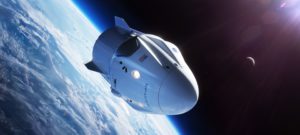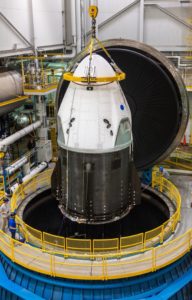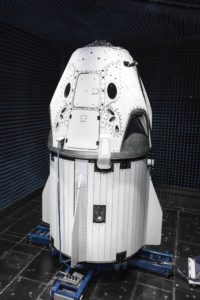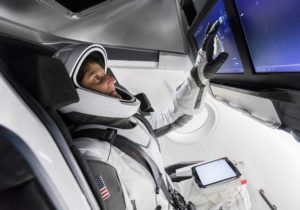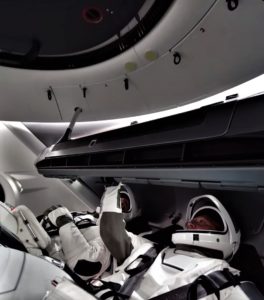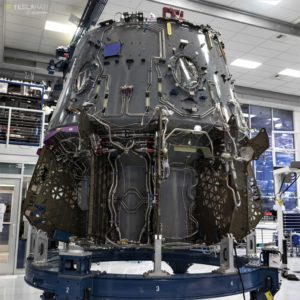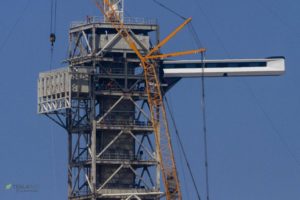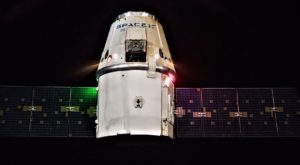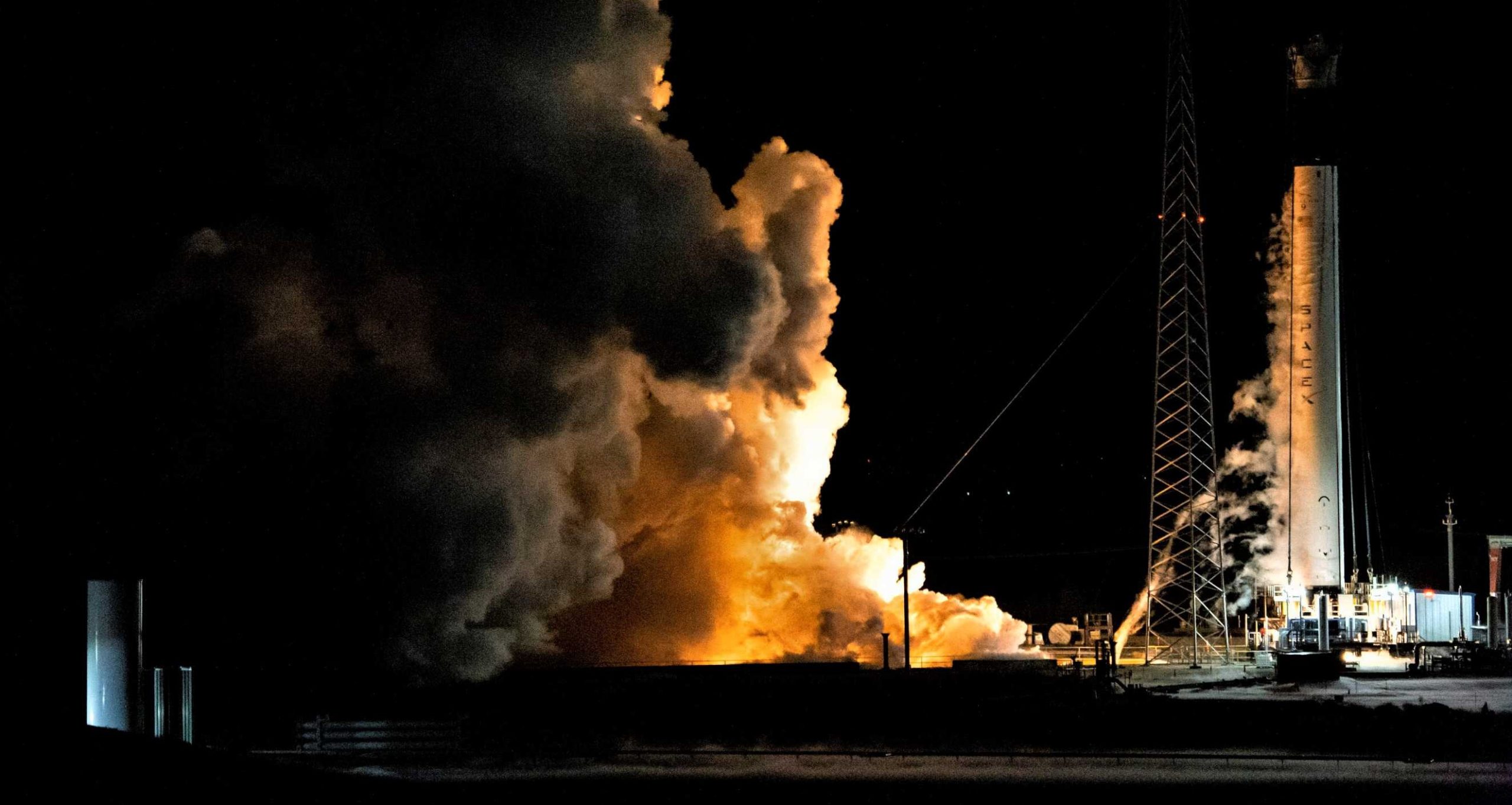
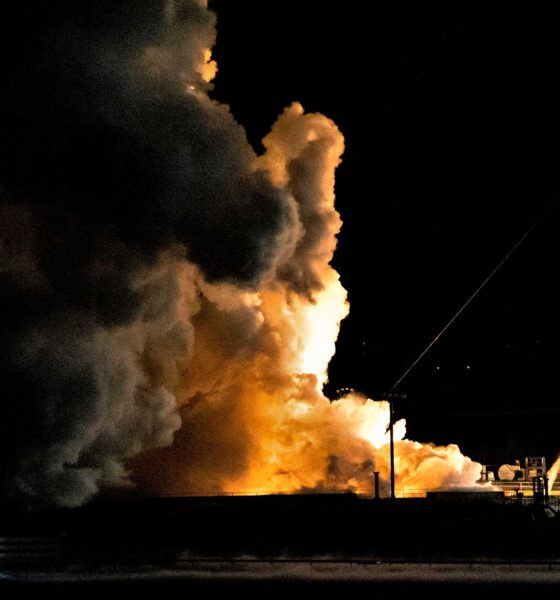
SpaceX
SpaceX’s Crew Dragon spacecraft nears launch debut as Falcon 9 tests wrap up
Known as Demonstration Mission 1 (DM-1), the inaugural flight of SpaceX’s Crew Dragon spacecraft is closer than ever before as the company wraps up ground testing of the rocket that will launch it.
Meanwhile, astronauts Doug Hurley and Bob Behnken are continuing to prepare for DM-2 – the first launch of Crew Dragon with crew onboard – by familiarizing themselves with SpaceX’s completed hardware, software, and procedures.
Commercial crew astronauts Bob Behnken and Doug Hurley are getting familiar with operating inside @SpaceX's Crew Dragon, fully suited! pic.twitter.com/41cqRwhzdp
— NASA Commercial Crew (@Commercial_Crew) November 2, 2018
Originally expected to occur before the end of 2017, Commercial Crew partners SpaceX, Boeing, and NASA have been forced to repeatedly delay the inaugural uncrewed and crewed launches of both the Crew Dragon (SpaceX) and Starliner (Boeing) crew transport vehicles, which have slipped roughly 3-6 months with every quarterly schedule update.
Generally speaking, the sources of those delays can be split evenly between NASA and its two commercial partners. A majority of the commercial-side slips can be attributed to unexpected hardware failures between the beginning of the Commercial Crew Program (CCP) and expected launch dates, with SpaceX experiencing two catastrophic failures of Falcon 9 (CRS-7 and Amos-6) and Boeing suffering a major anomaly while performing ground tests ahead of a Starliner pad-abort. Prior to the September 2016 Amos-6 failure of Falcon 9, SpaceX was arguably on track for the inaugural launch of Crew Dragon in late-2017/early-2018, having already completed a successful pad-abort demonstration in 2015 and eight successful launches since the CRS-7 failure.
- In this illustration, a SpaceX Crew Dragon spacecraft is shown in low-Earth orbit. (SpaceX)
- SpaceX’s Demo Mission-1 Crew Dragon seen preparing for vacuum tests at a NASA-run facility, June 2018. (SpaceX)
- The DM-1 Crew Dragon testing inside SpaceX’s anechoic chamber, May 2018. (SpaceX)
- NASA Astronaut Suni Williams, fully suited in SpaceX’s spacesuit, interfaces with the display inside a mock-up of the Crew Dragon spacecraft in Hawthorne, California, during a testing exercise on April 3. (SpaceX)
The Statue and the Hare
Aside from serious hardware failures, the rest of SpaceX’s Commercial Crew delays can be blamed on the company’s tendency to relentlessly iterate, improve, and generally modify both its hardware and software, to the extent that SpaceX’s Vice President of Production stated in mid-2018 that “[SpaceX has] never built any two vehicles identically”. For NASA’s often dysfunctionally and counterproductively risk-averse human spaceflight divisions, that sentence alone is probably enough to trigger panic attacks. As a result, SpaceX has been led to significantly change its style of operations over the last several years, reaching some sort of compromise that was more acceptable to NASA.
Further, despite the failures of CRS-7 and Amos-6, SpaceX continued to dramatically modify Falcon 9’s design – a major vehicle-wide upgrade known as Falcon 9 1.2 (Full Thrust, Block 1) debuted on the CRS-7 return-to-flight, while Amos-6 would have been the first launch of Falcon 9 Block 3 and likely failed as a result of faster fueling procedures and much colder propellant. Less than a year later, SpaceX debuted Falcon 9 Block 4. Roughly half a year after that, SpaceX debuted Falcon 9 Block 5, perhaps the most significant upgrade to the rocket yet. Ultimately, all changes made to Falcon 9 and Crew Dragon translate into additional work for NASA and SpaceX, known formally as “certification” and informally as exhaustive testing sandwiched by mountains of paperwork.
- DM-2 astronauts Bob Behnken and Doug Hurley train for their first flight in Crew Dragon. (NASA)
- SpaceX Crew Dragon capsule C203 – then assigned DM-2 – is seen here in August 2018. (Pauline Acalin)
- SpaceX installed its Crew Access Arm (CAA) in September 2018. (Tom Cross)
- SpaceX’s extraordinary custom spacesuit. Crew Dragon astronauts will wear this suit while inside the space capsule. (Pauline Acalin)
- A concert of Draco thrusters work to push Dragon away from the ISS and back towards Earth. (ESA)
In the case of the CCP, NASA itself has been a major source of delays as Boeing and SpaceX get much closer to launch dates and hardware is effectively completed, integrated, and ready to go. According to both Hans Koenigsmann (VP of Flight Reliability) and Gwynne Shotwell (President and COO) in the last few months, both executives were supremely confident that the hardware (Crew Dragon: capsule, trunk; Falcon 9: Merlins, upper stage, booster; Launch Complex 39A) would be ready for DM-1 no later than December 2018. Those statements imply that additional delays were unlikely to be a consequence of hardware readiness, indicating that delays beyond December would presumably be caused by paperwork and/or ISS scheduling.
In this sense, it could well be the case that NASA’s behind-schedule completion of critical certification and approval paperwork – paperwork that NASA alone required and knew it would have to finish prior to launch for the last several years – will or already have delayed SpaceX’s first Crew Dragon launch by at least a month. DM-1 is currently targeting a launch in January 2019.
For prompt updates, on-the-ground perspectives, and unique glimpses of SpaceX’s rocket recovery fleet check out our brand new LaunchPad and LandingZone newsletters!

Elon Musk
Starlink passes 9 million active customers just weeks after hitting 8 million
The milestone highlights the accelerating growth of Starlink, which has now been adding over 20,000 new users per day.

SpaceX’s Starlink satellite internet service has continued its rapid global expansion, surpassing 9 million active customers just weeks after crossing the 8 million mark.
The milestone highlights the accelerating growth of Starlink, which has now been adding over 20,000 new users per day.
9 million customers
In a post on X, SpaceX stated that Starlink now serves over 9 million active users across 155 countries, territories, and markets. The company reached 8 million customers in early November, meaning it added roughly 1 million subscribers in under seven weeks, or about 21,275 new users on average per day.
“Starlink is connecting more than 9M active customers with high-speed internet across 155 countries, territories, and many other markets,” Starlink wrote in a post on its official X account. SpaceX President Gwynne Shotwell also celebrated the milestone on X. “A huge thank you to all of our customers and congrats to the Starlink team for such an incredible product,” she wrote.
That growth rate reflects both rising demand for broadband in underserved regions and Starlink’s expanding satellite constellation, which now includes more than 9,000 low-Earth-orbit satellites designed to deliver high-speed, low-latency internet worldwide.
Starlink’s momentum
Starlink’s momentum has been building up. SpaceX reported 4.6 million Starlink customers in December 2024, followed by 7 million by August 2025, and 8 million customers in November. Independent data also suggests Starlink usage is rising sharply, with Cloudflare reporting that global web traffic from Starlink users more than doubled in 2025, as noted in an Insider report.
Starlink’s momentum is increasingly tied to SpaceX’s broader financial outlook. Elon Musk has said the satellite network is “by far” the company’s largest revenue driver, and reports suggest SpaceX may be positioning itself for an initial public offering as soon as next year, with valuations estimated as high as $1.5 trillion. Musk has also suggested in the past that Starlink could have its own IPO in the future.
News
SpaceX shades airline for seeking contract with Amazon’s Starlink rival

SpaceX employees, including its CEO Elon Musk, shaded American Airlines on social media this past weekend due to the company’s reported talks with Amazon’s Starlink rival, Leo.
Starlink has been adopted by several airlines, including United Airlines, Qatar Airways, Hawaiian Airlines, WestJet, Air France, airBaltic, and others. It has gained notoriety as an extremely solid, dependable, and reliable option for airline travel, as traditional options frequently cause users to lose connection to the internet.
Many airlines have made the switch, while others continue to mull the options available to them. American Airlines is one of them.
A report from Bloomberg indicates the airline is thinking of going with a Starlink rival owned by Amazon, called Leo. It was previously referred to as Project Kuiper.
American CEO Robert Isom said (via Bloomberg):
“While there’s Starlink, there are other low-Earth-orbit satellite opportunities that we can look at. We’re making sure that American is going to have what our customers need.”
Isom also said American has been in touch with Amazon about installing Leo on its aircraft, but he would not reveal the status of any discussions with the company.
The report caught the attention of Michael Nicolls, the Vice President of Starlink Engineering at SpaceX, who said:
“Only fly on airlines with good connectivity… and only one source of good connectivity at the moment…”
CEO Elon Musk replied to Nicolls by stating that American Airlines risks losing “a lot of customers if their connectivity solution fails.”
American Airlines will lose a lot of customers if their connectivity solution fails
— Elon Musk (@elonmusk) December 14, 2025
There are over 8,000 Starlink satellites in orbit currently, offering internet coverage in over 150 countries and territories globally. SpaceX expands its array of satellites nearly every week with launches from California and Florida, aiming to offer internet access to everyone across the globe.
Currently, the company is focusing on expanding into new markets, such as Africa and Asia.
News
Tesla hints at Starlink integration with recent patent
“By employing polymer blends, some examples enable RF transmission from all the modules to satellites and other communication devices both inside and outside the vehicle.”

Tesla hinted at a potential Starlink internet terminal integration within its vehicles in a recent patent, which describes a vehicle roof assembly with integrated radio frequency (RF) transparency.
The patent, which is Pub. No U.S. 2025/0368267 describes a new vehicle roof that is made of RF-transparent polymer materials, allowing and “facilitating clear communication with external devices and satellites.”
Tesla believes that a new vehicle roof design, comprised of different materials than the standard metallic or glass elements used in cars today, would allow the company to integrate modern vehicular technologies, “particularly those requiring radio frequency transmission and reception.
Tesla has recently filed a US patent application on integrating RF transparent materials into the roof structure.
“facilitating clear communication with external devices and satellites”
Tesla fleet is getting @Starlink connectivity integration soon. LFG @Tesla @elonmusk… pic.twitter.com/bLa8YtPLd1
— Chansoo Byeon (@Chansoo) December 9, 2025
Instead of glass or metallic materials, Tesla says vehicles may benefit from high-strength polymer blends, such as Polycarbonate, Acrylonitrile Butadiene Styrene, or Acrylonitrile Styrene Acrylate.
These materials still provide ideal strength metrics for crashworthiness, stiffness for noise, vibration, and harshness control, and are compliant with head impact regulations.
They would also enable better performance with modern technologies, like internet terminals, which need an uninterrupted signal to satellites for maximum reception. Tesla writes in the patent:
“By employing polymer blends, some examples enable RF transmission from all the modules to satellites and other communication devices both inside and outside the vehicle.”

One of the challenges Tesla seems to be aware of with this type of roof design is the fact that it will still have to enable safety and keep that at the forefront of the design. As you can see in the illustration above, Tesla plans to use four layers to increase safety and rigidity, while also combating noise and vibration.
It notes in the patent that disclosed examples still meet the safety requirements outlined in the Federal Motor Vehicle Safety Standards (FMVSS).
Starlink integrated directly into Tesla vehicles would be a considerable advantage for owners. It would come with a handful of distinct advantages.
Initially, the inclusion of Starlink would completely eliminate cellular dead zones, something that is an issue, especially in rural areas. Starlink would provide connectivity in these remote regions and would ensure uninterrupted service during road trips and off-grid adventures.
It could also be a critical addition for Robotaxi, as it is crucial to have solid and reliable connectivity for remote monitoring and fleet management.
Starlink’s growing constellation, thanks to SpaceX’s routine and frequent launch schedule, will provide secure, stable, and reliable internet connectivity for Tesla vehicles.
Although many owners have already mounted Starlink Mini dishes under their glass roofs for a similar experience, it may be integrated directly into Teslas in the coming years, either as an upgrade or a standard feature.
